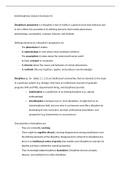Interdisciplinary research Summary H2
Disciplinary perspective is a discipline’s view of reality in a general sense that embraces and
in turn reflects the ensemble of its defining elements that include phenomena,
epistemology, assumptions, concepts, theories, and methods.
Defining elements of a discipline’s perspective are
- The phenomena it studies
- Its epistemology or rules about what constitutes evidence
- The assumptions it makes about the natural and human world
- Its basic concepts or vocabulary
- Its theories about the causes and behaviors of certain phenomena
- Its methods (the way it gathers, applies, and produces new knowledge)
Disciplines (p. 36 - tables 2.1, 2.2) are intellectual communities that are devoted to the study
of a particular subject (e.g. biology), they have an institutional structure of graduate
programs (MA and PhD), departmental hiring, and disciplinary journals.
o Subdiscipline is a subdivision of an existing discipline (e.g. cultural
anthropology)
o Interdiscipline is between two or more disciplines. It might start as an
interdisciplinary field, but over time it can become more like a discipline by
developing its own curriculum, journals, professional associations, and
perspective (e.g. biochemistry or neuroscience)
Characteristics of disciplines are
- They are constantly evolving
- There might be cognitive discord, meaning disagreement among practitioners over
the defining elements of the discipline. Disagreement is inherent to disciplines but
there is an intellectual center of gravity that enables each discipline to maintain its
identity and have a distinctive overall perspective.
- They increasingly cross disciplinary boundaries. Disciplines borrow concepts,
theories, and methods from other disciplines
, Disciplinary perspectives are used in two circumstances
- In the beginning of the research process where the focus is on identifying disciplines
that are potentially interested in the problem. A rule of thumb is to let the problem
dictate which categories and disciplines within each category are most relevant to it.
- Is later when you are developing adequacy in relevant disciplines and analyzing the
problem. A discipline’s perspective is not identical with the insights the discipline
produces. Interdisciplinarians analyze the insights and theories resulting from a
discipline, they identify how they conflict, modify them by creating common ground,
integrate them, and construct a more comprehensive understanding of the problem.
The defining elements of disciplines explained
- Phenomena (p. 41 - tables 2.3, 2.4) are enduring aspects of human existence that are
of interest to scholars and are susceptible to scholarly description and explanation.
o Disciplines and their interest are ever changing, and logical classification of
phenomena does not exist, so:
Several disciplines can share phenomena and might be oblivious to the
work of other disciplines on that phenomenon.
Certain phenomena might be completely missed by the focus on other
phenomena. (e.g. economic growth might be relevant to history or
political science, but has not been studied specifically)
o Two ways of identifying relevant phenomena for problems:
Serially (Table 2.3)-> where you approach disciplines in hopes of
finding relevant phenomena to investigate
Focusing on the phenomenon itself-> where you focus on relevant
phenomena and subsequently look which disciplines are relevant
o Formerly, only the serial approach was available because there was only a
classification of disciplines based on their perspective (perspectival approach
table 2.2) available. However, Szostak classified the phenomena from most
general, left, to most specific, right, to see links between phenomena
(classification approach table 2.4).






